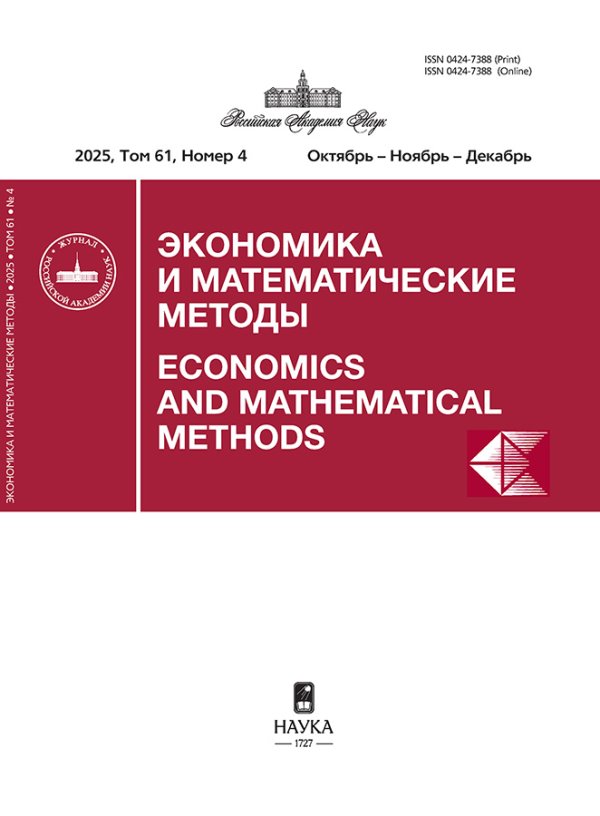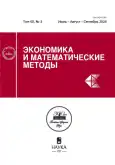Том 60, № 3 (2024)
Теоретические и методологические проблемы
Взаимосвязь результативности инновационной деятельности промышленных предприятий с показателями технологической новизны продукции
Аннотация
В работе исследуется связь результативности инновационной деятельности российских предприятий промышленности с уровнем технологической новизны выпускаемой ими инновационной продукции. Для этого вводится инновационная функция, которая отображает зависимость «выхода (то есть результата инновационного процесса), от факторов, измеряемых затратами на процессные и продуктовые инновации. При анализе данной функции учитывается взаимосвязь между этими двумя видами затрат. Обсуждаются гипотезы относительно свойств инновационной функции. В качестве показателя технологической результативности используется отношение величины выпуска инновационной продукции к затратам ресурсов, необходимых для ее производства. Исследуется зависимость показателя результативности от затрат на инновации. Находятся точки локальных максимумов показателя результативности (локальных технологических оптимумов) для разных размерных классов российских промышленных предприятий. Показано, что существует взаимосвязь между результативностью инновационной деятельности и уровнем технологической новизны инновационной продукции. В качестве показателя уровня технологической новизны используется доля выпуска радикально новой во всей инновационной продукции. В результате анализа определено, что при приближении к технологическому оптимуму (по мере повышения показателя результативности инновационной деятельности) происходит смена ориентации инновационного производства с выпуска радикальной на выпуск инкрементальной инновационной продукции.
 5-19
5-19


Мировая экономика
Экологическая трансформация капитализма
Аннотация
Конференция ООН по изменению климата (COP28) (Объединенные Арабские Эмираты, Дубай с 30 ноября по 12 декабря 2023 г.) показала провал мировой стратегии, заложенной в целях Парижского соглашения по климату. Это побуждает вернуться к проблеме дополнительных мер защиты природной среды обитания за счет перехода к умеренным темпам роста экономики, численности населения и антропогенной нагрузки на природную среду. Статья посвящена экологическим пределам роста мировой капиталистической системы, ее экономики и численности населения планеты. Во имя сохранения природной среды обитания капитализму неотвратимо предстоит трансформация в новую посткапиталистическую формацию, способную обеспечить умеренную антропогенную нагрузку на среду обитания одновременно с ростом достигнутого уровня благосостояния населения и сохранением природной среды обитания для будущих поколений. В опасной близости от экологических пределов роста предстоит отказаться от господствующих целей максимизации прибыли, расширения масштабов экономики, численности населения. Предлагается также переориентировать население развивающихся стран мира на умеренную рождаемость за счет возрастания индексов человеческого развития и качества жизни, особенно в странах с их низким уровнем при высоком приросте численности населения. Предложена трехмерная система измерителей экономического роста, модель экономического роста, сбалансированного с состоянием природной среды.
 20-29
20-29


Модель «векового» цикла накопления финансового капитала
Аннотация
Масштабные кризисы, с которыми сталкивается мировая экономика с конца прошлого столетия, вряд ли можно считать случайными. Согласно теории системных циклов накопления Д. Арриги в них проявляется завершающая фаза очередного «долгого века» — эпохи глобального доминирования американского капитала. Данная теория обладает высоким аналитическим и прогнозным потенциалом, но не встречает широкого признания. Этому, в частности, препятствует ее недостаточная формализация. Цель настоящего исследования — представить базовую математическую модель «векового» цикла накопления капитала и верифицировать ее. Особенность предлагаемого подхода заключается в моделировании скорости прироста капитала. Она измеряется процентными ставками или доходностями; их номинальные величины представляют собой темпы возрастания финансового капитала как всеобщей формы капитальной стоимости. Адекватным инструментом моделирования выступает дифференциальное логистическое уравнение. Объектом анализа стали британский и американский системные циклы, предметом — динамика доходностей в Великобритании в XVIII–XIX вв. и в США в XX в. — начале XXI в. Полученные результаты выявили определяющую роль финансового капитала как экономической основы системного цикла и подтвердили гипотезу о том, что его накопление происходит по S-образной траектории. Кроме того, с привлечением статистики торгового баланса уточнено содержание двух фаз цикла — как периодов внутренней и внешней экспансии капитала.
 30-42
30-42


Народнохозяйственные проблемы
Динамический межотраслевой баланс как инструмент анализа структурной политики
Аннотация
Настоящая работа расширяет круг инструментов анализа и разработки структурной политики за счет применения динамического межотраслевого баланса, записанного в виде системы обыкновенных дифференциальных уравнений. Это стало возможным после публикации нами ранее вариантов оцифровки и калибровки такой структурной модели и перевода ее из набора чисто теоретических конструкций во множество вычислимых и практически полезных моделей. Формально оцифровка модели возможна при введении в научный оборот и расчете матрицы собственных (внутриотраслевых) и взаимных (межотраслевых) инерционностей, элементы которой имеют размерность времени. Сама вводимая в рассмотрение матрица располагается в модели на месте матрицы приростных фондоемкостей. Последняя отличается всеми научными обоснованиями, однако нам не известно ни одного статистического института в мире, который разрабатывает эту матрицу и публикует для экономики какой-либо страны или региона мира. Матрица приростных фондоемкостей в мировой статистике тотально отсутствует. Вторым фактором, обеспечивающим практическую ценность модели, является использование для ее калибровки матрицы коэффициентов финансовых потоков. Выполненные и представленные расчеты позволяют заключить, что на интервале публикации Росстатом базовых таблиц «затраты–выпуск» модель обеспечивает уверенное прогнозирование валового производства в текущих и сопоставимых ценах. В предлагаемом виде модель претендует на использование в качестве одного из инструментов анализа структурных изменений в отечественной экономике, для сопоставлений экономической динамики России с тенденциями в других развитых и развивающихся экономиках. Оцифровка модели для регионов позволила бы выполнять аналогичную работу на мезоуровне.
 43-53
43-53


Региональные проблемы
Моделирование качества жизни Санкт-Петербурга и регионов Северо-Запада
Аннотация
Статья посвящена применению методологии экономики качества для получения научно обоснованных оценок качества жизни в регионах Северо-Западного федерального округа. Направлена на развитие исследований, связанных с поиском возможных направлений воздействия на социально-экономическую систему, способствующих повышению качества жизни населения в условиях цифровизации (по данным Санкт-Петербурга и регионов Северо-Западного федерального округа). В ходе исследования выполнено моделирование качества жизни для регионов Северо-Западного федерального округа. Проведена базовая и комплексная оценка качества жизни, которая позволила проследить более чем десятилетнюю динамику показателя, провести группировку регионов, выявить и обосновать их общие и обличительные особенности в контексте проведенного исследования. Анализ отдельных характеристик качества жизни регионов СЗФО показал, что можно измерить вклад, который вносят медико-демографические условия, социально-экономическое благополучие, комфортность и безопасность среды жизнедеятельности в показатель качества жизни. По результатам исследования сделан вывод о значимости оценки вклада данных составляющих для определения вектора проведения политики регионального развития. В интересах раскрытия перспективных возможностей получения алгоритмических решений в области стандартизации управления качеством жизни региона предложен новый формат многоуровневой системы управления качеством. Применение цифровизированного формата принятия управленческих решений в многоуровневой системе управления качеством многократно повысит их эффективность за счет расширения возможностей анализа сложных данных без четких взаимосвязей, в том числе для прогнозирования и оптимизации процессов, протекающих на локальном, региональном, национальном уровнях.
 54-69
54-69


Отраслевые проблемы
Экосистемная модель развития отрасли беспилотных авиационных систем
Аннотация
Статья посвящена анализу структурных преобразований российской промышленности в контексте внешних ограничений и необходимости обеспечения технологического суверенитета в высокотехнологичных отраслях. Научной гипотезой работы является предположение о важности межотраслевой координации субъектов промышленной политики в целях развития производства критически важной продукции. В качестве объекта исследования рассматривается цифровая промышленная экосистема отрасли беспилотных авиационных систем (БАС). Цель исследования является разработка основ структуры экосистемной модели развития отрасли БАС и обоснование целесообразности ее применения в интересах совершенствования высокотехнологичных отраслей промышленности Российской Федерации. В статье предлагаются авторские трактовки понятий «цифровая промышленная экосистема» и «межотраслевая экосистема», обосновываются принципы функционирования экосистемной модели и ее архитектура. Разработана экосистемная модель развития отрасли БАС, включая органы управления, техническую инфраструктуру, организационно-экономические инструменты, технологические кластеры и сеть участников. Основной отличительной особенностью предлагаемой модели от существующих является распределенность органов управления экосистемой, поддерживающих автономность управления на всех горизонтальных и иерархических уровнях ее организации. Экосистема рассматривается в качестве инструмента механизма стратегического развития высокотехнологичных отраслей, участвующих в создании БАС гражданского назначения, и обеспечивает межотраслевое взаимодействие участников в целях ускоренного развития промышленного производства и становления рынка БАС. Экосистемная модель управления обеспечит владение актуальными данными фактических и планируемых индикативных оценочных показателей состояния и развития отрасли в масштабе времени, близкому к реальному, на основе принципа цифровой прозрачности.
 70-81
70-81


Ценовой индекс на компьютерные игры: что скрыто от невооруженного глаза?
Аннотация
В данной работе представлено исследование ценовой динамики широкого спектра видеоигр в период с 2008 по 2020 г. В ходе исследования создана необходимая для анализа база данных; проводится моделирование цен видеоигр эконометрическими методами и конструируются ценовые индексы для различных игровых жанров: ролевые (RPG, Role-Playing Game), стратегии (Strategy), экшн-игры (Action), приключения (Adventure), казуальные игры (Casual), инди-игры (indie), симуляторы (Simulators) и др. Гипотетически разброс цен на видеоигры по разным жанрам и системным требованиям обусловлен разным объемом усилий, необходимых для их создания. В ходе конструирования гедонистических ценовых индексов производится очищение цен от характеристик качества продуктов (компьютерных игр). В роли характеристик используются системные параметры видеоигр. Также в работе применяются различные подходы к модификации гедонистических индексов путем рассмотрения неоднородности жанров. Благодаря исследованию удается отследить динамику стоимости видеоигр на рассматриваемом промежутке времени с представлением запаздывающих и опережающих тенденций. В конце исследования предлагается диверсификация жанров по ценовой эластичности ключевых переменных, которые были использованы в ходе построения моделей.
 82-93
82-93


Математический анализ экономических моделей
Агент-ориентированная модель трехуровневого иерархического минимаксного управления региональным промышленным комплексом
Аннотация
Опыт развитых стран свидетельствует об актуальности проблем управления территориальными промышленными комплексами. Необходимо создавать применимые на практике модели управления, опирающиеся на современные подходы и позволяющие его оптимизировать. Методологической базой исследования послужили теории экономики промышленности, экономико-математического моделирования, оптимального управления, оптимизации, игр. Методическую основу модели составляют агент-ориентированный подход, методы экономико-математического моделирования, методы построения систем управления социально-экономическими системами, минимаксный подход. В статье предложена трехуровневая модель управления региональным промышленным комплексом, определена ее иерархическая субъектно-объектная структура. Параметры промышленных объектов представлены в виде фазового вектора, а для каждого агента формализована структура управляющих и информационных связей и алгоритмы управляющих воздействий. Сформулированы решаемые в ходе использования модели задачи формирования множеств минимаксных управляющих воздействий для каждого агента; предложен общий алгоритм по выбору оптимальных управляющих воздействий. Модель позволяет реализовать ее в программной среде и создать инструмент моделирования процессов управления промышленным комплексом региона, а в дальнейшем — гибкий расширяемый программный инструментарий для управления промышленностью на региональном уровне.
 94-106
94-106


Методы оценивания интегрированной дисперсии: проблемы устойчивости к скачкам в высокочастотных временных рядах
Аннотация
Интегрированная дисперсия является мерой волатильности процесса в непрерывном времени и используется в финансовой математике как инструмент оптимизации портфеля, прогноза динамики цены финансового актива. Состоятельность оценки интегрированной дисперсии случайного процесса находится в центре внимания настоящей статьи. Основополагающий диффузионный процесс расширен посредством включения компоненты скачков как средства улучшения описательной функции процесса. Именно активность скачков является тем фактором, который обуславливает состоятельность оценки интегрированной дисперсии. Поэтому состоятельность оценки определяется как степень ее устойчивости к скачкам. Рассмотрены два основных метода оценивания интегрированной дисперсии и проанализирована способность соответствующих оценок в нейтрализации эффекта скачков на сходимость. Приведены доводы, указывающие на необходимость дальнейшего исследования эффекта скачков, ссылаясь на работы авторов, заложившие основу анализа интегрированной дисперсии, а также на работы, в которых содержатся основные асимптотические результаты относительно устойчивости оценки интегрированной дисперсии к скачкам. По результатам проведенного анализа выделены направления дальнейшего развития асимптотической теории для анализа состоятельности оценки интегрированной дисперсии.
 107-117
107-117


Деформация кривых волатильности российского фондового рынка на примере маржируемых опционов на фьючерсные контракты на индекс РТС
Аннотация
Актуальность исследования связана с необходимостью переоценки российского фондового рынка в части соотношения параметров риска c доходностью активов в связи с глобальными структурными изменениями, произошедшими в 2022 г. Предметом данного исследования выступают кривые волатильности, рассчитанные по котировкам биржевых опционов на фьючерсы индекса РТС. Цель исследования — проанализировать соотношения кривых волатильности с распределением доходности индекса широкого рынка акций РТС в 2015–2022 гг.; оценить изменения структуры такого соотношения в шоковом 2022 г. по сравнению с предыдущими периодами; рассмотреть возможности применять модели прогнозирования будущей волатильности GARCH в 2022 г. и хеджировать стратегии на российском фондовом рынке. Вопрос интерпретации динамики кривых волатильности является дискуссионным, однако достаточно теоретически разработанным в теории оценки производных финансовых инструментов. В результате исследования найдены не взаимосвязанные структуры распределения доходностей и кривых волатильности на сводный индекс РТС на всем рассматриваемом периоде, независимо от наличия внешних шоков. Сделан вывод о том, что на российском фондовом рынке инвесторы предпочитают защитные опционы, а не спекулятивные, несмотря на отрицательную асимметрию распределения доходности индекса РТС во всех рассматриваемых периодах. И, несмотря на больший вес положительных доходностей в распределении доходности индекса РТС на каждом рассматриваемом периоде в силу технических особенностей функционирования показателей доходности. Кроме того, обнаружено, что отрицательная асимметрия распределения доходности не обязательно должна соотноситься с растущими кривыми волатильности.
 118-128
118-128













